Email marketing is a fantastic way for you to keep in touch with your customers, learn about them, and create a loyal relationship between the two of you. It can be planned so that your customers receive your message at a specific time and that message is delivered right into their personal space: their inboxes.
Not many other marketing activities are such good all-rounders. With social media, it’s based on luck whether your message is seen or lost into the abyss that is a homepage feed. Direct mail sent via post is very personal, but it’s hard to measure the results. And your website could be top dollar when it comes to content, but it’s the decision of your customer whether to visit it or not.
So how do you make sure you’re using this fantastic marketing tool to its full potential? I’ve written five tips below that I’ve found to be essential when it comes to effective email marketing campaigns.
1. The Objective Of Email Marketing: Relationship Building Not Spam
If you’ve just discovered the magic of email marketing, don’t get overly excited and blast a message to all of your customers. Email marketing has garnered a bad reputation from spammers: those who send irrelevant emails, or possibly even phishing emails to get your bank details, and those who send multiple emails a day – usually without having sought permission from you to send you information.
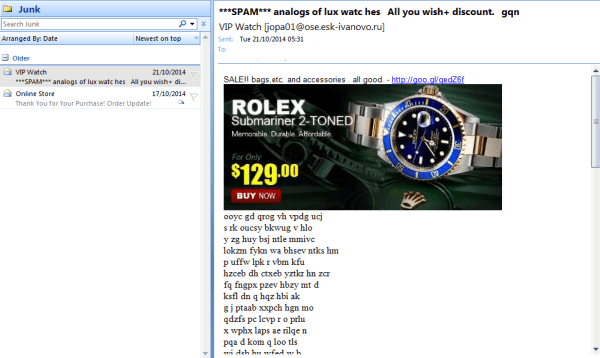
Don’t be a spammer. You can segment your customers into lists, which we’ll get into later. This allows you to tailor the content of your email to certain customers, rather than sending all of your customers every single thing you want to say or item you want to promote.
Also make sure the language of your emails comes across as professional but friendly. You want your customers to trust what you’re saying as well as generate a warm feeling toward your brand. The objective is to build a relationship with your customer and you won’t get this if your language is all about sales promotions and how great your company is. Focus instead on how your customer can benefit from buying from you.
2. The Power Of Data
A huge positive for email marketing is the ability to collect data and then use what you know about your customer to build a relationship with them. You only get this chance through direct marketing and email is a great tool since it’s quick and easy to use.
Initially, your customers give you their email address for you to send them information. This first step in the relationship is actually a huge leap, as it signifies that the customer wants to hear more from you. You can obtain a few more bits of information on sign up too, such as their age and gender. You can then use this to send them more relevant communications.
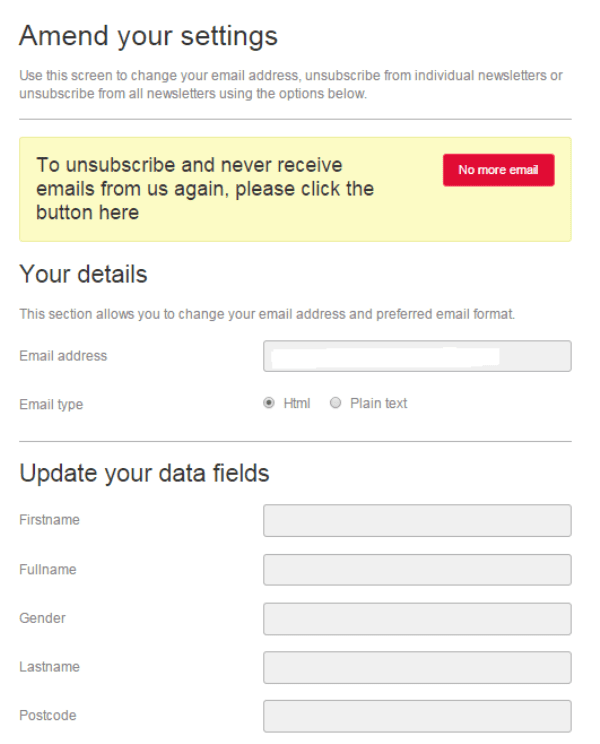
You can also use this data to personalize your emails. The most obvious way to do this would be to add the customer’s name into the subject line or introduction to catch their attention. But be careful about too much personalization, especially early on in the relationship. Customers are wary of spammers or of having their data shared across the internet. So sending a special offer for the customer’s birthday is perfectly fine, but displaying their age might just freak them out a little.
3. The Design And Message: It’s More Than Just A Pretty Template
Looks do count, but you need to put some thought into what you want your email to do. Go back to point one above and think about the objective of your email and then build this into the message. What action do you want your customers to take? Tell them!
You’ll need a good design and engaging copy to get their attention – this includes the subject line to get past the first hurdle of opening the email and the headline or “above the fold,” which is the space you first see upon opening the email without scrolling. But you also need to make sure the main body of the message tells them what to do next. You can even do this visually with a call-to-action button.
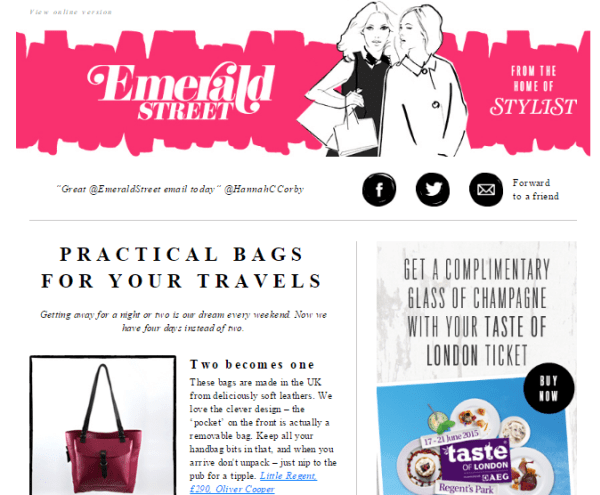
This could be a link to a page containing your sales products, a landing page explaining further details about your service, or a blog post updating customers on the latest news. Just make sure that your customers know that you’ve sent them this email to encourage them to visit the page and that the page is relevant to your email. Overall, it needs to be a tailored piece of communication, rather than just throwing out some information in the hope that your customers will visit your website.
A couple of other design points include adding your social media links so that your customers can share your message, which is great for reaching more prospects. It also gives your customers the chance to build your relationship further if they choose to on another platform.
Also, make sure your email includes a message to add the “from” email address to their safe senders list to avoid it jumping into the spam box. And of course, you’ll need an unsubscribe option. This is legal but it also makes it clear to your customers that they’re in this relationship through their own choosing.
4. Learn From Your Results
Seeing the results of your email marketing campaign is the exciting part. There are the basics of how many people received, opened, and clicked through your emails – data which you should record and compare against each campaign to track its performance.
Email service providers like MailChimp and Aweber will go into more detail. You can often see visually where people have clicked, which can inform you how to layout your email and what type of content you should be including on your emails.
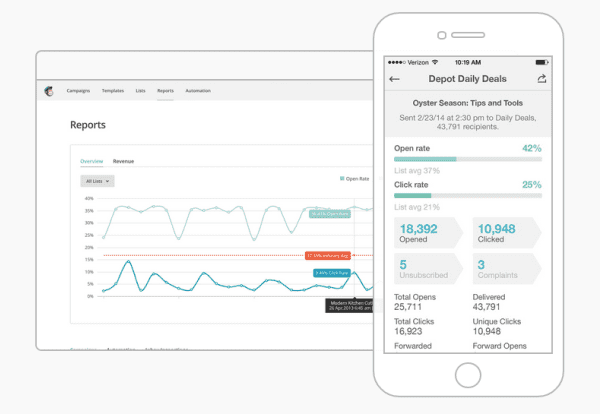
You can also drill down into the data for individuals so that you can build up a picture of their behaviors and preferences. Let’s say you’re an outdoor clothing retailer and your emails contain a variety of products on offer. If someone is only interested in biking gear, which you can see from the links that they’ve clicked, then there’s no point in sending them an email specifically about skiing clothes and equipment. You’ll get a much larger response rate and return on investment if you lump your biking enthusiasts into one pot and send them bike-specific content.
This level of detail in the data requires some work by a person with a technical mind and data analytics skill-set, but it’s well worth the investment. Once you know your customers, you can simply segment them into different mailing lists and select which message they are going to receive. It works for price sensitivity, lifecycle stage, and demographics too.
5. Test Away!
Of course you need to test your email on different devices and browsers before you blast it out to thousands of customers, but that’s not what I’m getting at in this point. Just like with your results, I’m talking about creating tests and learning from them.
You might want to test different offers, email designs, landing pages, or subject lines. All can be done and then the winner rolled out through AB split testing. This technique is where you have two emails the same, split between equally proportioned data sets that contain similar profiled customers, but change one small thing at a time.
For instance, if you have a new offer that you’d like to test, you can’t send this offer AND have a different background image on your test email to your original email, otherwise you won’t know if it’s your offer or image that’s created the difference. Similarly, if you want to change your email design, you’ll need to keep the original design and test just one new design at a time to make the test against the old design fair.
Testing also allows you to find out what works best for your brand. Search the internet for “best time to send a marketing email” and your search results will come back with many conflicting answers. The problem is that those times work best for the author or the sample that a study was completed on, but that’s not necessarily best for you.
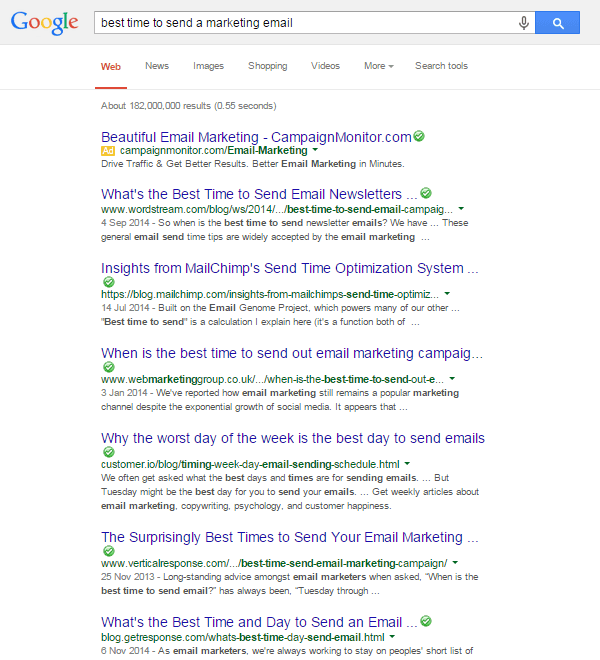
So set up a test by sending the same email to different sets of data with a similar profile at various points throughout the day or week and this will give you a good indication of your most effective time.
Wrapping Up
There’s an animation doing the rounds at the moment comparing the 80s to the present, where in the 80s we were sick of receiving paper letters through the door but loved seeing an email pop up in our inboxes. Now, it’s the exact opposite.
As we’ve moved to these digital times, it is trickier to get your email and message seen above everyone else’s. This is especially so when you throw in the advertising and social media messages that your customers see online on a day-to-day basis.
But if you do it right, it’s incredibly an incredibly value tool for not only promoting your message and delivering it right underneath your customer’s nose, but for learning about your offer, brand, and most importantly; your customers. Build that relationship with your customers and they’ll keep coming back for more.
Article thumbnail image by 0beron / shutterstock.com









Great article Brenda!! If businesses follow all the tips cited in the content, they will be able to successfully run an email marketing campaign. Just one point to add – the usage of right email marketing platform. Apart from the tips and strategies that you have mentioned, it is essential that businesses focus on the right email marketing platform as well. New-age CRMs like ConvergeHub are the perfect fit for small businesses since they help to manage customers and also provide the option to frame, schedule and automatically send email messages to leads and prospects. Its reports and analytics features are an added plus point that empowers businesses to get a detailed analysis of the campaign result.
To make it easy for readers to scan your message, keep columns of copy narrow.
Spammers are really giving email marketing campaigns a hard time. Some people find it hard to recognize spams and legitimate emails. I guess times has really change. Email marketing is still effective though especially if you connect with the right audience.
Great post Brenda- I think what really gets annoying about email marketing is those subject messages. I wish more businesses realised that writing ‘OMG open now’ and ‘You HAVE to see this’ is not a viable way to retain real interest!
Thanks for the tips. Also very well written…
Hi Brenda,
This is so useful and helpful to me, who still in phase of learning more about email marketing. I learn a lot from here, and I feel more understand about email marketing now. From here too, I think I still in the phase of “The Design And Message: It’s More Than Just A Pretty Template”, because for me, design part is so difficult. But still, I will try to apply it more.
Thanks again Brenda.
Very useful, clear article. Well written Brenda.
I am always gentle when it comes to email marketing.
Thanks for the tips. I’m still learning all the bells and whistles of email marketing but I think it can be very powerful if done right.
At them moment I’m trying to adjust my autoresponder to sell a digital product and also another one to sell web design services – both totally different animals.
I think testing is key and my email campaigns will evolve over time.
Anyway, great article thanks again.
Brenda, another great article from a fellow Whovian! The problem with “best time to send an email” is the time zones — what is best for the West Coast of the USA may be 3:00am down here in Australia! So the first point is to look at your target market and their location, then try to find a time to suit the majority. Then test, test, test.
Philip, re-read Brenda’s comments above about segmenting your list, that is vital for you! I would suggest setting up two separate lists, one for the digital product and one for the web design services, because the target markets will probably be different so you will want to promote to each list differently.
Obviously you can still MENTION your web services to the digital product buyers and vice versa, but don’t overdo it. Treat the two lists as separate customers and promote to each accordingly. Good luck with the business!
Terry